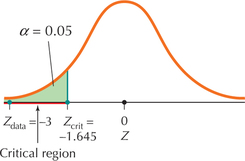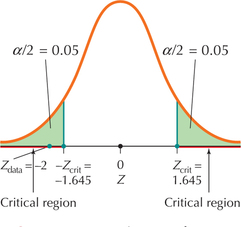9.2 Z Test for the Population Mean: Critical-Value Method
OBJECTIVES By the end of this section, I will be able to …
- Explain the essential idea about hypothesis testing for the population mean.
- Calculate the test statistic Zdata.
- Find the critical region(s) and critical value(s) for a hypothesis test.
- Perform the Z test for the mean, using the critical-value method.
1 The Essential Idea About Hypothesis Testing for the Mean
Recall that in Section 9.1, we wanted to determine whether the population mean systolic blood pressure μ was less than 110 and we considered the hypotheses
H0:μ=110 versus Ha:μ<110
We stated that a large difference between the observed sample mean ˉx and the hypothesized mean μ0=110 would result in the rejection of the null hypothesis H0. The question is, “How large is large?”
The Z test for the mean tells us when our results are statistically significant. To learn how this test works, consider the following: A sample of n=25 patients who are taking the medication shows a sample mean systolic blood pressure level of ˉx=104. Further assume that the population standard deviation systolic blood pressure reading is σ=10, and that the population of such readings is normal. Would this value ˉx=104 represent sufficient evidence to reject H0 and conclude that μ<110?
Recall from Chapter 7 that the sampling distribution of the sample mean ˉx is the collection of sample means of all possible samples of size n. When the population is normal, or the sample size is large, the sampling distribution of ˉx is approximately normal, with mean μˉx=μ and standard error σˉx=σ/√n. The idea behind the Z test is to determine where our sample mean ˉx=104 falls within the sampling distribution. Is ˉx=104 somewhere near the middle of the sampling distribution, or is it an outlier? Now, if H0 is true, then μ=μ0=110 and we may standardize ˉx to get
Z=ˉx-μ0σ/√n
Substituting, we get
Z=ˉx-μ0σ/√n=104-11010/√25=-3
In other words, ˉx=104 lies 3 standard errors below the hypothesized mean μ0=110. Thus, if we accept that the null hypothesis is true, then ˉx=104 is an outlier, an extreme value (see Figure 1). That is, if H0 is true, then the probability of observing ˉx≤104 is very small (P(Z<-3)=0.0013), because the corresponding Z-value lies in the tail of the distribution, and nearly all the values of ˉx are greater than 104.
Note: Here, we are using Facts 1–4 and the Central Limit Theorem from Chapter 7.
We are developing the Z test using a left-tailed test, but the same idea applies to right-tailed tests and twotailed tests, too.

Thus, we must choose one of the following two scenarios:
- H0 is true, the value of μ0 is accurate, and our observation of this extreme value of ˉx is an amazingly unlikely event.
- H0 is not correct, and the true value of μ is closer to ˉx.
Developing Your Statistical Sense
The Data Prevail!
When faced with the above situation, because we don't want to base our decisions on “amazingly unlikely events,” we therefore would conclude that H0 is not correct. Remember that the null hypothesis is just a conjecture, but the sample mean ˉx represents directly observable “hard data.” The scientific method states that, when there is a conflict between a conjecture and the observed data, the data prevail, and we need to rethink our null hypothesis.
This conclusion illustrates the essential idea about hypothesis testing for the mean.
The Essential Idea About Hypothesis Testing for the Mean
When the observed value of ˉx is unusual or extreme in the sampling distribution of ˉx that assumes H0 is true, we should reject H0. Otherwise, we should not reject H0.
All the remaining parts of Sections 9.2–9.4, all the steps and all the calculations, are really just ways to implement this essential idea. Stated roughly: If the difference between ˉx and μ0 is large, then reject H0. Otherwise don't.
2 Test Statistic Zdata
The Z statistic that we calculated earlier
Z=ˉx-μ0σ/√n
contains four quantities—three of which are taken from data. The sample mean ˉx and the sample size n are characteristics of the sample data, and the population standard deviation σ represents the population data. Thus, we call this statistic Zdata.
The Test Statistic Zdata
The test statistic used for the Z test for the mean is
Zdata=ˉx-μ0σ/√n
Zdata summarizes the information in the data set regarding the hypothesis test.
For the blood pressure data, we have
Zdata=ˉx-μ0σ/√n=104-11010/√25=-3
Zdata is an example of a test statistic, a statistic generated from a data set for the purposes of testing a statistical hypothesis. We will discuss several other test statistics throughout the remainder of the text. The hypothesis test in this section and Section 9.3 is called the Z test because the test statistic Zdata comes from the standard normal Z distribution.
EXAMPLE 7 Calculating Zdata

 Clothing Store Sales
Clothing Store Sales
Retail stores need to generate sales. A sample of 100 customers' data was taken from the Chapter 9 Case Study data set, Clothing Store, and the total sales were obtained for each customer during the six-month time period. Suppose this sample showed a sample mean of ˉx=$480. Assume the population standard deviation is σ=$670. The district manager has set a goal to achieve a population mean of more than $413 total sales per customer.
- Construct the hypotheses.
- Calculate the test statistic Zdata.
Solution
Using our strategy for constructing the hypotheses from Section 9.1, the key words “more than” means “>,” and the “>” symbol occurs only in the right-tailed test. Answering the question “More than what?” is μ0=413. Thus, our hypotheses are
H0:μ=413 versus Ha:μ>413
where μ represents the population mean total sales per customer.
The sample size is n=100, with a sample mean of ˉx=480, and σ=670. Thus,
Zdata=ˉx-μ0σ/√n=480-413670/√100=1
NOW YOU CAN DO
Exercises 9–22.
YOUR TURN#3
For Example 7, suppose everything else stayed the same, but now n=36. Calculate Zdata.
(The solution is shown in Appendix A.)
Zdata standardizes the distance between the sample mean ˉx and the hypothesized population mean μ, so that this distance is now on the standard normal scale. Thus, we can sometimes tell with a glance at Zdata, using our knowledge of the standard normal Z distribution (Section 6.4), whether ˉx is extreme or not, and therefore whether to reject. Specifically, we recall that almost all values of Z lie between −3 and 3. Here are two examples:
- Say our data provides us with a value of Zdata=12, which is far into the tail of the Z distribution. This represents a very extreme value of ˉx, and so we will reject H0.
- Suppose the data set gives us a value of Zdata=0.27, which is near the center of the Z distribution. This represents a value of ˉx fairly close to μ0, and so we will not reject H0.
Of course, not all cases are as obvious as these, thus the need for the hypothesis testing procedure.
3 Critical Regions and Critical Values
In the critical-value method for the Z test, we compare Zdata with a threshold value, or critical value of Z, called Zcrit. The value of Zcrit separates Z into two regions (see Table 4):
- Critical region: the values of Zdata for which we reject H0
- Noncritical region: the values of Zdata for which we do not reject H0
- The critical region consists of the range of values of the test statistic Zdata for which we reject the null hypothesis.
- The noncritical region consists of the range of values of the test statistic Zdata for which we do not reject the null hypothesis.
- The value of Z that separates the critical region from the noncritical region is called the critical value Zcrit.
Zcrit represents the boundary between values of Zdata that are statistically significant and those that are not statistically significant. The value of Zcrit depends on the value of α, the probability of wrongly rejecting H0. A smaller value of α will make it harder to reject H0, that is, harder to find statistical significance. Thus, α is called the level of significance of the hypothesis test.
The value of Zcrit depends on (a) the form of the hypothesis test, and (b) the level of significance α. Table 4 shows values of Zcrit for the most commonly used levels of significance α. It also shows the location of the critical region.
| Form of hypothesis test | |||
|---|---|---|---|
| Right-tailed | Left-tailed | Two-tailed | |
| Level of significance α | H0:μ=μ0 | H0:μ=μ0 | H0:μ=μ0 |
| Ha:μ>μ0 | Ha:μ<μ0 | Ha:μ≠μ0 | |
| 0.10 | Zcrit=1.28 | Zcrit=-1.28 | Zcrit=1.645 |
| 0.05 | Zcrit=1.645 | Zcrit=-1.645 | Zcrit=1.96 |
| 0.01 | Zcrit=2.33 | Zcrit=-2.33 | Zcrit=2.58 |
| Critical region |

|
||
| Rejection rule: | Reject H0 if Zdata≥Zcrit | Reject H0 if Zdata≤Zcrit | Reject H0 if Zdata≤-Zcrit or Zdata≥Zcrit |
EXAMPLE 8 Finding Zcrit and the critical region
For the hypotheses,
H0:μ=110 versus Ha:μ<110
where μ represents the population mean systolic blood pressure, let the level of significance α=0.05.
- Find the critical value Zcrit.
- Graph the distribution of Z, showing the critical region.
Solution
We have a left-tailed test and level of significance α=0.05, so Table 4 tells us that the critical value is Zcrit=-1.645. The graph showing the critical region is provided in Figure 2. We would reject H0 for values of Zdata that are ≤Zcrit=-1.645.

NOW YOU CAN DO
Exercises 23–26.
YOUR TURN#4
In Example 7, we had the hypothesis test:
H0:μ=413 versus Ha:μ>413
where μ represents the population mean total sales per customer. Let the level of significance α=0.10.
- Find the critical value Zcrit.
- Graph the distribution of Z, showing the critical region.
(The solutions are shown in Appendix A.)
Developing Your Statistical Sense
Why Is It Called a Left-Tailed Test Mean? Right-Tailed Test? Two-Tailed Test?
A hypothesis test of the form
H0:μ=μ0 versus Hα:μ<μ0
is called a left-tailed test because the critical region lies in the left (lower) tail. Similarly, a hypothesis test of the form
H0:μ=μ0 versus Hα:μ>μ0
is called a right-tailed test because its critical region lies in the right (upper) tail. Finally, a hypothesis test of the form
H0:μ=μ0 versus Hα:μ≠μ0
is called a two-tailed test because its critical region occupies both the lower and upper tails.
4 Performing the Z test for the Mean Using the Critical-value Method
We are now ready to learn the steps for performing the Z test for the population mean using the critical-value method.
Z Test for the Population Mean μ: Critical-Value Method
When a random sample of size n is taken from a population where the population standard deviation σ is known, you can use the Z test if (a) the population is normal, or (b) the sample size is large (n≥30).
Step 1 State the hypotheses.
Use one of the forms from Table 4. State the meaning of μ.
Step 2 Find Zcrit and state the rejection rule.
Use Table 4 and the given level of significance α.
Step 3 Calculate Zdata.
Zdata=ˉx-μ0σ/√n
Step 4 State the conclusion and the interpretation.
If Zdata falls in the critical region, then reject H0; otherwise, do not reject H0. Interpret your conclusion.
What Does This Conclusion Mean?
Interpreting Your Conclusion
Recall that a data analyst needs to interpret the results so that the general public can understand them. You can use the following generic interpretation for the two possible conclusions. Just remember that generic interpretations are no substitute for thinking clearly about the problem and the implications of the conclusion.
Interpreting the Conclusion
- If you reject H0, the interpretation is: There is evidence at level of significance α that [whatever Ha says].
- If you do not reject H0, the interpretation is: There is insufficient evidence at level of significance α that [whatever Ha says].
For example, suppose our conclusion for the hypotheses in Example 8
H0:μ=110 versus Ha:μ<110
was to reject H0. Then the interpretation of this conclusion would be: There is evidence at level of significance α=0.05 that the population mean systolic blood pressure reading is less than 110.
Next, we illustrate the critical-value method of performing a right-tailed Z test, a left-tailed Z test, and a two-tailed Z test for μ.
EXAMPLE 9 Z Test for μ, critical-value method, right-tailed test
 Clothing Store Sales
Clothing Store Sales
For the situation in Example 7, test at level of significance α=0.01 whether the population mean total sales per customer is more than $413.
Solution
We may apply the Z test because the sample is large (n≥30), and the population standard deviation σ is known.
Step 1 State the hypotheses.
From Example 7, our hypotheses are
H0:μ=413 versus Ha:μ>413
where μ represents the population mean total sales per customer.
 FIGURE 3 Critical region for a right-tailed test.
FIGURE 3 Critical region for a right-tailed test.Step 2 Find Zcrit and state the rejection rule.
We have a right-tailed test and level of significance α=0.01, which, from Table 4, tell us that Zcrit=2.33. Because we have a right-tailed test, the rejection rule will be “Reject H0 if Zdata≥Zcrit,” that is, “Reject H0 if Zdata≥2.33” (see Figure 3).
Step 3 Find Zdata.
From Example 7, we have Zdata=1.
Step 4 State the conclusion and interpretation.
Our rejection rule states that we will reject H0 if Zdata≥2.33. Because Zdata=1, which is not ≥ 2.33, the conclusion is to not reject H0 (Figure 4). Even though the sample mean of ˉx=480 exceeds μ0=413, it does not do so by a wide enough margin to overcome the reasonable doubt that the difference between ˉx and μ0 may have been due to chance. We interpret our conclusion as follows: “There is insufficient evidence at the 0.01 level of significance that the population mean total sales is greater than $413 per customer over the six-month period.”
NOW YOU CAN DO
Exercises 37–40.
EXAMPLE 10 Z Test for μ, critical-value method, left-tailed test
For the hypotheses in Example 8, perform the Z test for the population mean, using level of significance α=0.05. Assume systolic blood pressure is normally distributed.
Solution
We may use the Z test, because the population of systolic blood pressure readings is normally distributed, and the population standard deviation σ is known.
Step 1 State the hypotheses.
From Example 8, we have
H0:μ=110 versus Ha:μ<110
where μ represents the population mean systolic blood pressure reading.
 FIGURE 4 Critical region for a left-tailed test.
FIGURE 4 Critical region for a left-tailed test.Step 2 Find Zcrit and state the rejection rule.
Example 8 gives us the critical value Zcrit=-1.645, and Table 4 tells us that, for level of significance α=0.05, we will reject H0 if Zdata≤Zcrit, that is, if Zdata≤-1.645 (Figure 4).
Step 3 Calculate Zdata.
From page 499, we know that
Zdata=ˉx-μ0σ/√n=104-11010/√25=-3
Step 4 State the conclusion and the interpretation.
In Step 2, we stated that we would reject H0 if Zdata≤-1.645. Our Zdata of -3≤-1.645, therefore, we reject H0. Our interpretation is: “There is evidence at level of significance α=0.05 that the population mean systolic blood pressure reading is less than 110.”
NOW YOU CAN DO
Exercises 41–44.
EXAMPLE 11 Z Test for μ, critical-value method, two-tailed test
When the level of hemoglobin in the blood is too low, a person is anemic. Unusually high levels of hemoglobin are also undesirable and can be associated with dehydration. The optimal hemoglobin level is 13.8 grams per deciliter (g/dl). Suppose a random sample of n=25 women at a certain college showed a sample mean hemoglobin of ˉx=11.8 g/dl, the population standard deviation of hemoglobin level is σ=5 g/dl, and hemoglobin level is normally distributed. We are interested in testing whether the population mean hemoglobin level differs from 13.8 g/dl. Perform the appropriate hypothesis test, using level of significance α=0.10.
Solution
We may use the Z test, because the population of hemoglobin levels is normally distributed, and the population standard deviation σ is known.
Step 1 State the hypotheses.
The key words “differs from” indicate a two-tailed test, with μ0=13.8. Thus, our hypotheses are
H0:μ=13.8 versus Ha:μ≠13.8
where μ represents the population mean hemoglobin level.
 FIGURE 5 Critical region for a two-tailed test.
FIGURE 5 Critical region for a two-tailed test.Step 2 Find Zcrit and state the rejection rule.
We have a two-tailed test and level of significance α=0.10. Using this information, Table 4 tells us that the critical value Zcrit=1.645 and that we will reject H0 if Zdata≤-1.645 or if Zdata≥1.645 (Figure 5).
Step 3 Calculate Zdata.
We have ˉx=11.8, n=25, σ=5, and μ0=13.8. Substituting:
Zdata=ˉx-μ0σ/√n=11.8-13.85/√25=-2
Step 4 State the conclusion and the interpretation.
Zdata=-2, which is ≤−1.645. Therefore we reject H0. There is evidence at level of significance α=0.10 that the population mean hemoglobin level differs from 13.8 g/dl.
NOW YOU CAN DO
Exercises 45–48.